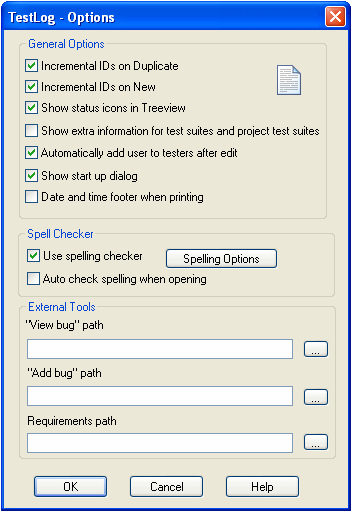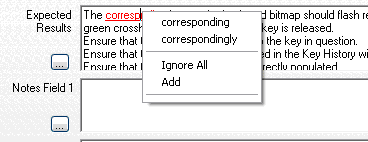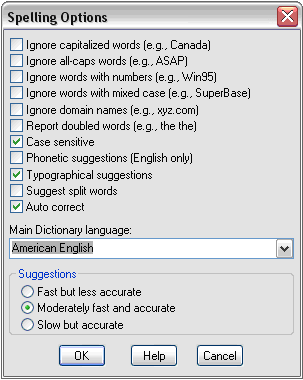Options



|
Options |



|
|
Options Dialog
These values are saved for the current instance of TestLog, any changes will affect how all databases are opened with this current installation of TestLog.
General Options
Incremental Ids on Duplicate: If this option is selected, TestLog will attempt to generate an incremental name when a selected item is duplicated. For example, if a test case named “Test0001” is selected and the duplicate option is chosen and then duplicated, the duplicated test case will be named “Test0002”.
Incremental Ids on New: If this option is selected, TestLog will attempt to generate an incremental name when a new item is created. For example, if a test suite contains a test case named “Test0001” and a new test case is created, the new test case will have a default ID of “Test0002”.
Show status icons in Tree view: If this option is selected, the icons representing the current status of project test cases will be displayed in the Tree view. This can add extra load time when opening or refreshing a database so turning this off might increase performance in databases with large amounts of test cases.
Show extra information for test suites and project test suites: If this option is selected the “Total Expected Duration” column will appear in the “Test Cases” list view for the first level of test suites and “Total Actual Duration” and “Percent Passed” will appear in the “Project test cases” for all first level project test suites. “Total Expected Duration” is the sum of all the expected durations for the test cases and sub test cases. “Total Actual Duration” is the sum of all the actual durations for the test cases and sub test cases. “Percent Passed” is the percentage of project test cases that have a status of pass.
Automatically add user to testers after edit: If this option is selected, when a user makes edits a test case and makes any changes they will be added to the testers field for that test case if they are not already present there.
Show start up dialog: Unchecking this option will stop displaying the startup options dialog when TestLog starts and instead start TestLog with no loaded database.
Date and time footer when printing: Display the page number, date and time in a footer when printing items from TestLog. Spell Checker
Use spelling checker: When this option is selected, the current control in an edit window will be spell checked when it receives the focus, if it is able to be spell checked, and newly typed words will be spell checked. Click the Spelling Options button to change the spelling configuration options, such as the dictionary used.
Auto check spelling when opening: This option will run a spell check on all applicable fields when an edit dialog is opened. Turning this on will increase the time it takes to open an item for editing.
External Tools
“View bug” path: The "View bug" path should be the command used by the bug tracker to view a bug, minus the identifying parameter. When the "View" button is clicked on the project test case edit screen it will add the data from the Fault Report ID field. For example the "1" value in the Fault Report ID field will be added to the value "http://localhost/bugzilla/show_bug.cgi?id=" from the "View bug" path" to form "http://localhost/bugzilla/show_bug.cgi?id=1". An attempt will then be made to open this location in the default browser. The %TL_PROJECT% flag can also be used and TestLog will replace this flag with the current project name when creating a link, eg "http://localhost/bugzilla/show_bug.cgi?project=%TL_PROJECT%&id=" will become "http://localhost/bugzilla/show_bug.cgi?project=SampleDB&id=1" in a project named SampleDB.
“Add bug” path: The "Add bug" path should be the command used by the bug tracker for adding a new bug. This address will be opened in the default browser when the "Add" button on the project test case edit dialog is clicked. Once the bug has been added you will need to paste the new bug number in the Fault Report ID field manually as this information cannot be retrieved by TestLog. The %TL_PROJECT% flag can also be used in the field (as described above).
For more information and an example please see http://www.testlog.com/support/bug_tracking.htm
Requirements Path: This can be a path to an external tool or web service for your requirements management tool. It functions similar to the paths above, if it is a link to a website it will append the contents of the requirements field to the address. If it is an executable program it will open the program and pass the contents of the requirements field as a parameter. If this field is left blank the requirements field will be treated as a path to a document and attempt to open the document in the program the document type is associated with.
 Options dialog
Spelling Options Dialog
When the spelling checker option is turned on and a spelling mistake is found it will become underlined and red. Right clicking on the miss-spelt word will bring up a menu of spelling suggestions. Choosing one of these suggestions will replace the word.
Choosing the “Add” option will add the current word to the dictionary. Choosing “Ignore All” Causes this and all further occurrences of a misspelled word to be skipped. You might use this option if the word reported as a misspelling is actually spelled correctly. If the word is one you use frequently, you may wish to add it permanently by selecting the “Add“ option  Spelling suggestions
There are also quite a few options that can be set for the spelling checker;
Ignore Capitalized Words: When enabled, any words beginning with a capital letter are ignored (i.e., are skipped over without being checked). You might enable this option if the text being checked contains many proper names.
Ignore All-Caps Words: When enabled, any words containing all capital letters are ignored (i.e., are skipped without being checked). You might enable this option if the text being checked contains many acronyms.
Ignore Words with Numbers: When enabled, any words containing embedded digits are ignored (i.e., are skipped without being checked). Examples of such words include Win95 and Q4. You might enable this option if the text being checked contains many code words or other symbols containing digits.
Ignore Words with Mixed Case: When enabled, any words containing an unusual mixture of upper- and lower-case letters are ignored (i.e., are skipped without being checked). Examples of such words include MicroHouse and CapsLock. You might enable this option if the text being checked contains many variable names or other symbols which use case changes to distinguish words.
Ignore Domain Names: When enabled, any words that appear to be Internet domain names (such as www.testlog.com) are ignored (i.e., are skipped without being checked).
Report Doubled Words: When enabled, any word appearing twice in a row is reported.
Case Sensitive: When enabled, a distinction is made between capitalized and non-capitalized words. For example, canada is considered different from Canada, so canada would be reported as a misspelling. When the option is disabled, canada and Canada are considered identical. Note that the performance of the spelling checker will be reduced if this option is disabled.
Phonetic Suggestions: When enabled, suggestions are made based on phonetic (sounds-like) similarity to the misspelled word. This option tends to improve suggestions for badly misspelled words. Enabling this option will increase the time required to locate suggestions. Note that either this option or the Typographical Suggestions option must be enabled or no suggestions will be offered.
Typographical Suggestions: When enabled, suggestions are made based on typographical (looks-like) similarity to the misspelled word. This option is appropriate for people who are generally good spellers. Note that either this option or the Phonetic Suggestions option must be enabled or no suggestions will be offered.
Suggest Split Words: When enabled, two separate words will be suggested as a replacement for a misspelling containing two joined words. For example, “is the” would be suggested as a replacement for “isthe”.
Auto Correct: When enabled, words marked with "Auto Change" actions will automatically be changed to their specified replacements. When disabled, you will be prompted before the words are changed.
Main Dictionary Language: This option allows you to set the language of the main dictionary used to check spelling. The list shows only languages for which dictionaries are installed on your system. To check spelling in a different language, select the language in the list.
Suggestions: Determines the speed and accuracy of the initial search for suggested replacements for misspelled words. When a misspelled word is detected, a search is automatically made for suggestions. This option controls the speed and accuracy of this automatic search.
OK button: Closes the Options Dialog, and saves any changes made to the option settings. Cancel button: Closes the Options Dialog, and discards any changes made to the option settings.
 Spelling options
|